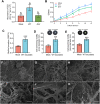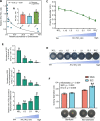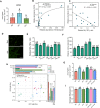Hyphosphere microorganisms facilitate hyphal spreading and root colonization of plant symbiotic fungus in ammonium-enriched soil
- PMID: 37443341
- PMCID: PMC10504341
- DOI: 10.1038/s41396-023-01476-z
Hyphosphere microorganisms facilitate hyphal spreading and root colonization of plant symbiotic fungus in ammonium-enriched soil
Abstract
Anthropogenic nitrogen inputs lead to a high ammonium (NH4+)/nitrate (NO3-) ratio in the soil, which restricts hyphal spreading of soil fungi. Access of symbiotic fungi to roots is a prerequisite for plant-fungal interactions. Hyphosphere bacteria protect fungi from environmental stress, yet the impact of hyphosphere bacteria on adaptation of host fungi to NH4+-enriched conditions remains unclear. By developing soil microcosm assays, we report that a plant-symbiotic fungus, Phomopsis liquidambaris, harbors specific hyphosphere bacteria that facilitate hyphal spreading and assist in the root colonization in NH4+-enriched soil. Genetic manipulation, 16S rRNA gene analysis and coinoculation assays revealed that the genus Enterobacter was enriched in the hyphosphere of NH4+-sensitive wild-type compared to NH4+-preferring nitrite reductase-deficient strain. The representative Enterobacter sp. SZ2-promoted hyphal spreading is only evident in nonsterilized soil. We further identified an increased abundance and diversity of ammonia-oxidizing archaea (AOA) and a synchronously decreased NH4+:NO3- ratio following SZ2 inoculation. Microbial supplementation and inhibitor assays showed that AOA-mediated reduction in NH4+:NO3- ratio is responsible for SZ2-enhanced fungal adaptation to NH4+-enriched conditions. The Ph. liquidambaris-Enterobacter-AOA triple interaction promoted rice growth in NH4+-enriched soil. Our study reveals the essential role of hyphosphere microorganism-based hyphal spreading in plant-fungal symbiosis establishment within nitrogen-affected agroecosystems.
© 2023. The Author(s), under exclusive licence to International Society for Microbial Ecology.
Conflict of interest statement
The authors declare no competing interests.
Figures








Similar articles
-
Root endophyte differentially regulates plant response to NO3- and NH4+ nutrition by modulating N fluxes at the plant-fungal interface.Plant Cell Environ. 2022 Jun;45(6):1813-1828. doi: 10.1111/pce.14304. Epub 2022 Mar 21. Plant Cell Environ. 2022. PMID: 35274310
-
Endophytic Fungus Drives Nodulation and N2 Fixation Attributable to Specific Root Exudates.mBio. 2019 Jul 16;10(4):e00728-19. doi: 10.1128/mBio.00728-19. mBio. 2019. PMID: 31311876 Free PMC article.
-
Symbiotic fungal endophyte Phomopsis liquidambari-rice system promotes nitrogen transformation by influencing below-ground straw decomposition in paddy soil.J Appl Microbiol. 2019 Jan;126(1):191-203. doi: 10.1111/jam.14111. Epub 2018 Oct 29. J Appl Microbiol. 2019. PMID: 30240129
-
Arbuscular mycorrhizal fungi conducting the hyphosphere bacterial orchestra.Trends Plant Sci. 2022 Apr;27(4):402-411. doi: 10.1016/j.tplants.2021.10.008. Epub 2021 Nov 13. Trends Plant Sci. 2022. PMID: 34782247 Review.
-
Improving Nitrogen Use Efficiency in Aerobic Rice Based on Insights Into the Ecophysiology of Archaeal and Bacterial Ammonia Oxidizers.Front Plant Sci. 2022 Jun 13;13:913204. doi: 10.3389/fpls.2022.913204. eCollection 2022. Front Plant Sci. 2022. PMID: 35769304 Free PMC article. Review.
Cited by
-
Differentiated response mechanisms of soil microbial communities to nitrogen deposition driven by tree species variations in subtropical planted forests.Front Microbiol. 2025 Mar 12;16:1534028. doi: 10.3389/fmicb.2025.1534028. eCollection 2025. Front Microbiol. 2025. PMID: 40143871 Free PMC article.
-
Bacterial community in the hyphosphere of an arbuscular mycorrhizal fungus differs from that in the surrounding environment and is influenced by hyphal disruption.Mycorrhiza. 2025 Feb 15;35(1):10. doi: 10.1007/s00572-025-01186-8. Mycorrhiza. 2025. PMID: 39954130
-
Nitrogen cycle induced by plant growth-promoting rhizobacteria drives "microbial partners" to enhance cadmium phytoremediation.Microbiome. 2025 May 6;13(1):113. doi: 10.1186/s40168-025-02113-x. Microbiome. 2025. PMID: 40329393 Free PMC article.
-
Histone acetyltransferase Sas3 in Phomopsis liquidambaris promotes spermidine biosynthesis against Fusarium graminearum in wheat.Theor Appl Genet. 2025 Feb 8;138(2):48. doi: 10.1007/s00122-025-04833-y. Theor Appl Genet. 2025. PMID: 39921737
-
The Diverse Mycorrizal Morphology of Rhododendron dauricum, the Fungal Communities Structure and Dynamics from the Mycorrhizosphere.J Fungi (Basel). 2024 Jan 14;10(1):65. doi: 10.3390/jof10010065. J Fungi (Basel). 2024. PMID: 38248974 Free PMC article.
References
-
- Guether M, Balestrini R, Hannah M, He J, Udvardi MK, Bonfante P. Genome-wide reprogramming of regulatory networks, transport, cell wall and membrane biogenesis during arbuscular mycorrhizal symbiosis in Lotus japonicus. New Phytol. 2009;182:200–12. doi: 10.1111/j.1469-8137.2008.02725.x. - DOI - PubMed
-
- Harinikumar KM, Bagyaraj DJ. Spread of vesicular arbuscular mycorrhizal fungal hyphae in soil. Microbiol Res. 1995;150:77–80. doi: 10.1016/S0944-5013(11)80037-6. - DOI
Publication types
MeSH terms
Substances
LinkOut - more resources
Full Text Sources

